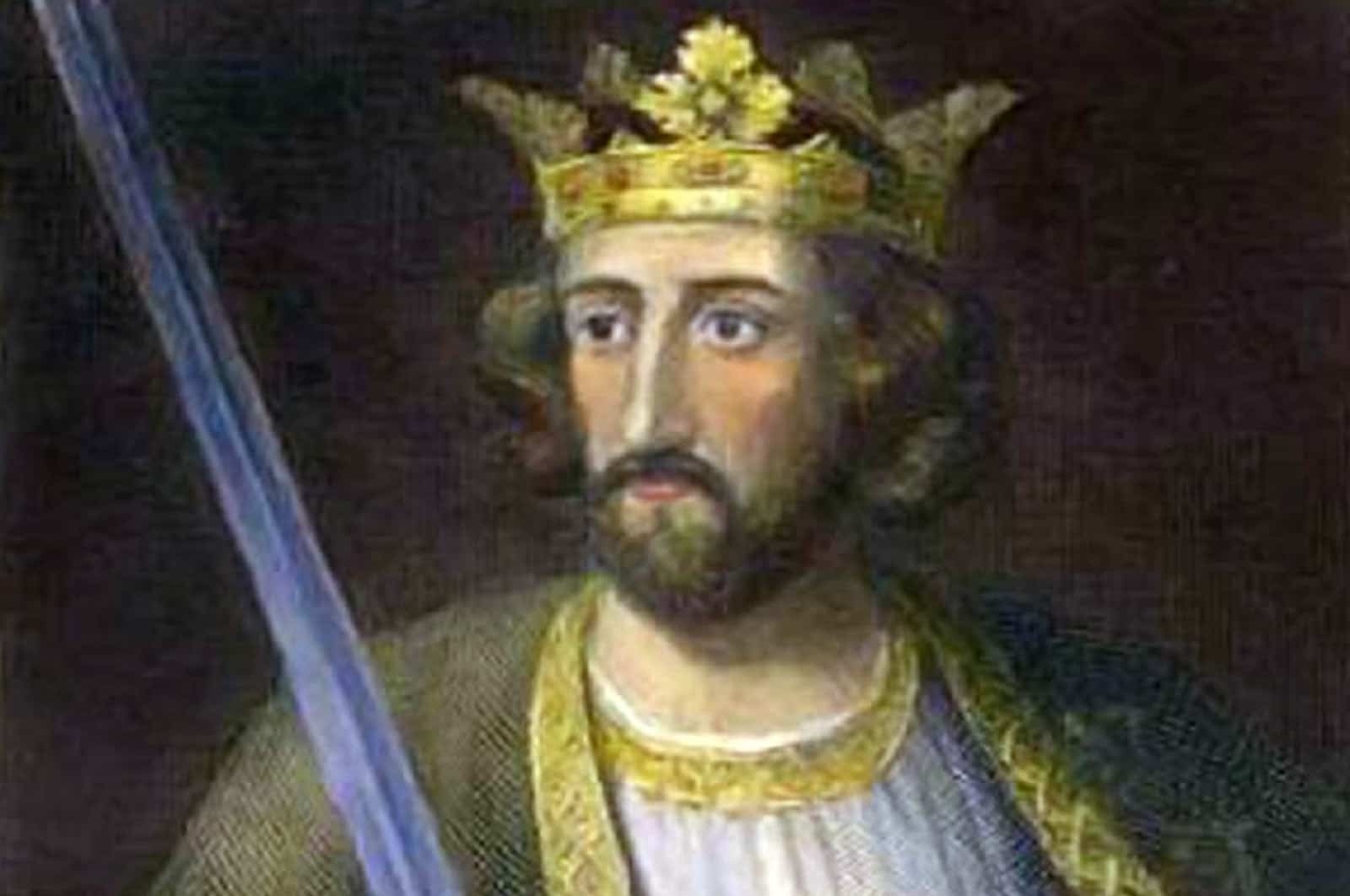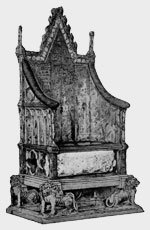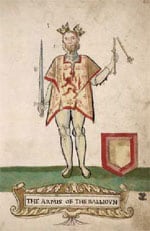King Edward I

Edward I, Brutal But Destined“Thus saith the Lord God; Remove the diadem, and take off the crown: this shall not be the same: exalt him that is low, and abuse him that is high. I will overturn, overturn, overturn it: and it shall be no more, until he come whose right it is; and I will give it him.” (Ezekiel 21: 26-27)
In the unfolding of His Plan, God positioned King Edward I as a man of great destiny. Eighteen centuries earlier the Throne of David had been transferred to Ireland when the prophet Jeremiah arrived with Jacob’s Pillar Stone and the eldest daughter of the slain King Zedekiah. Jeremiah arranged her marriage to King Eochaidh, thus fulfilling the first overturn of the throne as prophesied by Ezekiel. The second overturn took place around 500 AD when the Irish king, Fergus the Great, conquered Scotland and sent for the Stone and had himself crowned King of Scotland. Neither he nor the throne returned to Ireland, thus fulfilling the second part of God’s Promise. King Edward 1 was destined to overturn the throne for the third and final time.
The 1990’s movie, Braveheart, starring Mel Gibson, portrayed Edward 1 as a merciless individual bent only on subjecting the Scots, regardless of the cost. To an extent he was but this belies the importance of this greatest of all England’s medieval kings. In Volume 1 of his “History of the English Speaking Peoples” Winston Churchill described the king as “a mixture of the administrative capacity of Henry II and personal prowess and magnanimity of Coeur de Lion.” There was no doubting his love of war and he approached it with the same intense ferocity that he exhibited in jousting tournaments, in hunting or in hawking. Yet, he exhibited a great sense of justice and stood on the side of rights of all groups in his community. His reign was noted for many reforms, including the introduction of parliament, although his constant need of money to finance his wars with France and Scotland saw more power ceded to his parliamentarians than he might have liked. Yet, as Churchill also wrote, “Edward I succeeded in producing a broad, well-ordered foundation upon which an active monarchy could function in the general interest (of its subjects).”
 The Throne of David
The Throne of David
It was King Edward I who expelled the Jews from England because of their money lending practices. This must have been a somewhat painful act for the king because the Jewish lenders were a source of money for his military campaigns. Nevertheless, he didn’t have much choice, for as Churchill wrote, too many lands were falling into Jewish hands as a result of mortgage defaults and a universal hatred was building amongst the population. Not until the days of Oliver Cromwell, three centuries later, were the Jews able to return. Fortunately for Edward I, Italian moneylenders had begun operating in England and the king had his new source of money.
Notwithstanding that the first eighteen years of Edward’s reign witnessed an outburst of legislative activity for which there was no parallel for centuries (Churchill), King Edward I is remembered today as a warrior king. He acquired the name of Longshanks, not through any important military effort but because his long legs gave him a strong grip of the saddle. Yet, the name added to his reputation as a forceful warrior. In fact, he was away on Crusade when his father, Henry III, died in 1272 and didn’t return to England until 1274. Yet, when he did, he set into motion his great dream of uniting the island by bringing the Scots and Welsh into the realm. Wales fell after a number of battles and Edward bestowed upon his son the title of “Prince of Wales.” Scotland was a different story. Edward thought he had achieved his goal peacefully when Scotland’s king, Alexander III, accidentally rode his horse over a cliff in the dark of the night. In preparation for Alexander’s fourteen-year-old heir, Margaret, assuming the throne, the Scottish nobles that had become custodians of the Crown had placated England’s canny king by agreeing to her marriage to the king’s son, himself but a boy of six. Sadly, Margaret died on her voyage from Norway to receive the crown. Yet, her untimely death set the stage for the third overturn of Ezekiel 21: 26,27.
 Depiction of John Balliol
Depiction of John Balliol
Edward I didn’t let the tragedy disrupt his plans. Using all his manipulative skills while working behind the scenes, all the time simultaneously either bullying or currying favour with the Scottish nobility, Edward became the true power in a kingless Scotland. The two most visible claimants to the Scottish throne were John Balliol and Robert the Bruce. Both claimed descent from the twelfth century Scottish king, David I. Yet, it was Lord Balliol that the canny Edward selected in 1292 to be his puppet king. He had read the situation correctly because sadly, John Balliol was a man blinded by ambition. Indeed, so much so, that to gain the crown of Scotland, Balliol gave away his country’s independence by formally acknowledging Edward I of England as his overlord.
The rest is history. After his treason, Balliol came to recognize his great weakness. In 1294, he rebelled and attempted to throw off the yoke of servitude. However, his weak stature prevented him from garnering the vital support of the Scottish nobility or the Scottish citizens themselves. Consequently, his rebellion was short lived and in 1296, Edward invaded Scotland and deposed of Balliol. Then, through a pledge of allegiance, Edward forced the Scottish nobility to formally recognize his effective control. In his book “The Scottish Declaration of Independence”, Raymond Capt described the scene: “Edward I summoned 2,000 Scottish nobles to Berwick castle and demanded, as a price for peace that they put their seals to what was known as the Ragman Rolls, as recognition of his control over their kingdom.”
The third overturn of the Throne of David, as prophesied in Ezekiel 21: 26,27 was complete. A lingering question is “At what point did it take place?” Some students suggest it occurred when Balliol acknowledged Edward I as overlord in 1292, yet, despite his humiliation; Balliol was given the traditional coronation at Scone on the ancient Crowning Stone (Jacob’s Pillar Stone). Others suggest it took place in 1296 when Balliol was disposed and the Scottish nobles swore allegiance.
 The Philistines capture the Ark “God has left this place”
The Philistines capture the Ark “God has left this place”
Perhaps God has already shown us the answer. The Crowning Stone, referred to as Jacob’s Pillar Stone, The Stone of Scone and the Lia Fail, was taken to London upon the fall of Balliol, making him the last King of Scotland who was crowned upon the Stone. Edward I had a specially designed throne constructed to house the Stone and it has been used in the coronations of all but two English monarchs since Edward II first used it in his coronation. Ivan Panin, the notable numerologist and Bible scholar, demonstrated how God’s actions are hallmarked with sevens. So it should be no surprise that God employs an offshoot of seven here as well. For, exactly seven hundred years after the third overturn of the Throne of David, Jacob’s Pillar Stone was returned to Scotland. Moved away from venerable Westminster Abbey where so much apostasy has been evident in recent years. It’s almost as if God moved this symbol of David’s Throne to a safe setting pending that time of trouble leading to the return of the Lord Jesus Christ. There are precedents we should consider. When news of the Ark of the Covenant being in the hands of the Philistines was brought to Eli the priest at Shiloh, the shock killed him. This news in turn caused his daughter-in-law to give premature birth of her child. As she lay dying, she named her child “Ichabod,” signifying “The Glory is departed from Israel: because the Ark of God was taken.” (1 Samuel 4: 18-22). Or simply put, “God has left this place.” With the departure of Jacob’s Pillar Stone, has the glory also departed from Westminster Abbey and London? Has God left that place? Here’s something to think about! When God left Shiloh, that city was ultimately destroyed. When He left Jerusalem, i.e., when the Kingdom was taken from the Jews (Matthew 21: 43) the temple and the city were destroyed not long afterward. Maybe this is a warning to Westminster Abbey and London, the heart of financial Mystery Babylon. Certainly from the time the Stone was returned to Scotland, the morals of Britain and Britain’s feelings for God Almighty has been in freefall.
It must be mentioned that the movement of Jacob’s Pillar Stone does not signify an overturn of the Throne of David. The residing monarch, Queen Elizabeth, still occupies the throne. Yet, it is significant that the Stone was moved on November 14th, 1996, on Prince Charles’ birthday, who is said to want the Coronation Oath changed from “Defender of the Faith” to “Defender of Faiths.” This would be a mighty blow to the Reformation, yet does this seem that important anymore to a nation in apostasy.
“But as the days of Noe were, so shall also the coming of the Son of man be?”
Yet, God works in strange ways. We must ask, “Is there a greater significance for 1996?” Perhaps we should examine Genesis Chapter 7, particularly Verse 10. Noah was given exactly seven days warning of the commencement of the final judgment of the flood in his day. If we apply the day to a year as instructed in Ezekiel 4: 6, does it mean that God gave us seven years final warning of Judgment on November 14th, 1996? It’s interesting that 2003 marked the beginning of military involvement in the Middle East and the staggering cost that must be born on the backs of Anglo-Saxon countries. The changes in freedoms, morals, financial decline and love of God since that time can only signal a coming catastrophe. Could Jesus Himself have in part alluded to this when He said, “But as the days of Noe were, so shall also the coming of the Son of man be?” (Matthew 24: 37). Finally, dear reader, We must remember Jacob’s words when Judah was given the kingship in Genesis 49, “The scepter shall not depart from Judah, nor a lawgiver from between his feet, until Shiloh come; and unto him shall the gathering of the people be.” After all, Jesus did say, “Behold I have told you before” (Matthew 24: 25).
As for Edward I, his part in the unfolding of God’s Plan was complete. It was not his destiny to conquer Scotland. Yet, he did wreak havoc on the Scots until he closed his life eleven years after disposing of Balliol. After years of devastating war, he overcame the forces of William Wallace and sacked the country relentlessly for badly needed money. His victory was short-lived as another immortal Scot, the great military strategist and future king of Scotland, Robert the Bruce, took up the battle. Still, Edward never gave up and he died in 1307 leading an expedition to Scotland to take up the battle once again. Churchill described Edward I as being a lonely, wrathful old man in the closing years of his life. Probably he had no idea of the significance of his role. Indeed, Edward’s life reminds us of every man’s terrestrial struggle with shades of good and shades of evil. Sadly, in his case, as it so often the case with all of us, he didn’t quite understand his participation in God’s Celestial Sovereignty. Certainly, so much more could have been written on his tomb at Westminster Abbey but it simply says, “Here lies Edward I, the Hammer of the Scots.”

